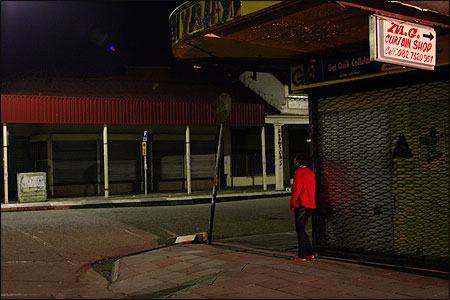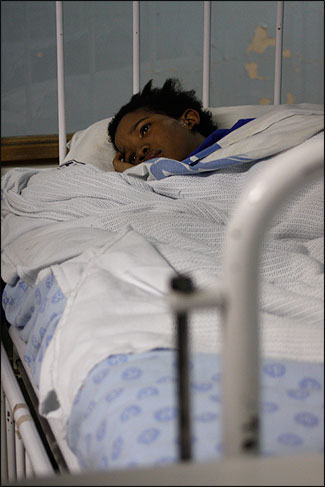
The Beat Goes On - Its Rhythm Changes
Beats form the backbone of a newsroom, so what happens when resources shrink, new voices emerge and platforms multiply? Which topics stick around? What new beats emerge? As Twitter cranks up the demand for constant interaction, how do beat reporters handle the daily grind? How do journalists connect with news consumers in a time of information overload? As e-book reading surges, is self-publishing the way to go? Dig in to these stories—and listen to Gabrielle Goodman perform our cover’s song that she wrote.

Reporting stories about girls like “Elizabeth,” who stands on a corner in Bloemfontein, South Africa, can mean that a journalist becomes involved in their lives in ways that can press up against journalism’s code of ethics. Photo by Melanie Hamman.
In its code of ethics, the Society of Professional Journalists (SPJ) lists as its first two principles: Journalists should “seek truth and report it” and “minimize harm” in the process. My beat is modern-day slavery, and for those who cover unfolding crimes against humanity, doing no harm does not mean doing nothing. I confess my bias: I am not for slavery. In fact, I hate it, and when victims have asked me for help to get free, and when there has been a way to aid their recovery responsibly, I have gotten involved.
Perhaps it’s simply the nature of this beat. Perhaps it’s me.
While on assignment for Time magazine to investigate sex trafficking in South Africa one freezing cold night in July 2009, I met two girls who desperately needed help. Several months earlier, a recruiter had lured the best friends out of their township, then sold them into sex slavery for $120 and a bag of crack cocaine. The buyer was a Nigerian pimp named Jude, who kept every penny the girls earned on the streets. Jude had kicked out the older one, Sindiswa, 17, a week before I met her, as she was too sick to work.
Now Sindiswa lay alone, dying in a state-run hospice in central Bloemfontein, feverish from AIDS, tuberculosis, and a first-trimester pregnancy. As she spoke, I wiped sweat from her brow with a paper napkin. Her fever was high and her T-cell count was bottoming out. She shivered, but her pillow was soaked. Next to the rusty bed lay one small duffel bag with all of her worldly possessions: two T-shirts, pants, raggedy lambskin slippers, and her toiletries. On her side table was a half empty bottle of Sprite and a bottle of the rehydrant Pedialyte. That was all that she had left in the world.
“I’m hungry,” she said, letting me know that she couldn’t eat the food that they fed her in the clinic. She could not move so she asked me to get her Kentucky Fried Chicken, of all things. Ironically, she wanted a meal called “Streetwise Two.” I fetched it for her, and then she told me her life story in 20 halting minutes.
“Thank you for being interested in my life,” she said after she began to fade out for the night.
“It’s an honor,” I responded. “Thank you for your courage.”
PHOTO ESSAY
"Visual Stories of Human Trafficking’s Victims"
- Melanie HammanShortly afterward, at midnight, by pure coincidence, Melanie Hamman, the photographer working with me, took a picture of a young girl working on the corner of a hotel that a trafficking syndicate had overrun. The girl was “Elizabeth,” Sindiswa’s best friend. She said that she was 15, and though she had failed in two previous escape attempts, she held out hope of breaking free from Jude. Hamman and I decided to act immediately and deliberately to help her to safety.

Sindiswa, who was sold into prostitution, died a week after she shared her life story with reporter E. Benjamin Skinner. Photo by Melanie Hamman.
Setting Rules for Reporting
Since I began reporting on modern-day slavery in 2002, I have interviewed hundreds of slaves, survivors, traffickers and abolitionists in some two dozen countries. I’ve logged more than one million flight miles. And yet I have only peered through a tiny window into the world of what the International Labor Office claims are 12.3 million forced laborers. Forced to perform services under threat of violence, for no pay beyond subsistence, slaves are among the world’s most vulnerable and fragmented populations. They are hidden everywhere and nowhere, in all major countries, in all 50 states, in brick kilns and underground brothels, in fisheries and private homes. And because slavery is a continuously unfolding crime against humanity, the SPJ’s code is particularly crucial for reporters who take on the subject.
“I only have one rule,” I typically tell slaves or survivors before an interview in which I ask them to bear honest witness about their lives. “You make the rules.”
The safety of slaves, survivors and other sources as well as fixers, translators and drivers is what matters, above all else. Informed consent of subjects can be a matter of life or death. As is true with most Western journalists reporting abroad, the dangers I face are minimal compared to those that my sources and confederates confront, and working primarily to ensure their safety normally means ensuring my own.
Such precautions extend to the editorial process as well. Of course I won’t change facts, but if a particular publication will permit it, I will change names. “Elizabeth,” for example, is not the real name of the victim mentioned above; Sindiswa insisted that I use her real name. I also will conceal certain biographical details of slaves and survivors in order to protect them from retaliation.
Most times these safety concerns dictate that it is not possible to get informed consent from criminally active traffickers before interviewing them. This means that certain publications that I work for will not publish information that I have gathered while undercover. Yet undercover work is indispensable—and, according to the SPJ, defensible if acknowledged in the publication—to getting the truth while protecting the safety of sources and confederates. Activists often warn of immediate blowback suffered by slaves when overt journalists confront traffickers: A human rights advocate in Nebraska alleged that traffickers recently gang-raped a young victim the night before she was scheduled for an interview.
In Romania during the summer of 2006, when interviewing a brutal pimp selling a disabled young woman out of an underground brothel, I knew that to break cover would be to risk the victim’s life. But the year before in Haiti, when I spoke with a trafficker who was operating in broad daylight on the street with no victim in sight, I could interview him openly as a journalist. That “broker,” as he called himself, was further emboldened by Haiti’s lack of human trafficking law enforcement. In both instances, I reported my findings to local authorities before publication.

Reporter E. Benjamin Skinner wipes the perspiration from Sindiswa’s brow as she lies in a hospital, pregnant, HIV-infected, and ill from tuberculosis. Photo by Melanie Hamman.
When the Story Ends
After publication, our responsibility for those that we write about and those who have helped us report remains. For Sydney Schanberg, that meant staying focused on Cambodia and working to contact Dith Pran, his reporting partner, whom Schanberg had left behind when Phnom Penh fell to the Khmer Rouge in 1975.
For me, that meant helping Bill Nathan. In 2005, Nathan, then the manager of a Port-au-Prince orphanage, told me his remarkable story of child domestic slavery and escape for my book, “A Crime So Monstrous: Face-to-Face With Modern-Day Slavery.” He also served as a guide, walking me through some of the Haitian capital’s toughest neighborhoods, including the gang-controlled community, Cité Soleil. Most importantly, he was my savior when I contracted a debilitating case of malaria, and he provided me with the chloroquine, food and shelter that helped me recover.
After this year’s catastrophic earthquake struck Haiti, Nathan wasn’t responding to calls I made to his cell phone, and I was worried. Miles Wright, treasurer of the North Carolina-based organization that supports Nathan’s orphanage, learned that Nathan had fallen some 80 feet off of its collapsing roof, breaking his back in the process. Wright and I worked together to pull strings and charter a tiny plane to Haiti with two surgeons and 200 pounds of medical supplies. Our main mission, however, was to extract Nathan, which we did less than 72 hours after the quake.
Here we were following a different set of priorities, those of disaster triage, which dictate that injured people who have the capacity to save others—doctors and other first responders—should be the first victims assisted. Nathan, who has saved hundreds of children through his work, was first on my list.
As I write this, I am with him in Raleigh, North Carolina, where he received excellent round-the-clock medical care to save his mobility. His flexibility is still a problem, but he has made a remarkable recovery and has spent much of the last few months raising funds and rebuilding the orphanage. He and others at the home have recently added a school for recovering child domestic slaves.
Whether deliberately or not, journalists change the lives of those whose lives we cover. For Sindiswa, sadly, I was too late. I was the first and last person to hear her short life story; she died a week after our interview. Elizabeth, on the other hand, is still free and, aided by a suburban Chicago couple who heard about my investigation, is home with her disabled mother. She faces serious challenges, but she is HIV-negative, and she has another shot at life.
Too often, the 24-hour TV news cycle leaves viewers with the impression that journalists’ professional detachment in covering global crises borders on misery tourism. I have rarely encountered journalists thus inclined. And as icons—Edward R. Murrow to Samantha Power to Nicholas Kristof, to name a few—have shown, journalists’ reports on horrific human rights abuses don’t have to be articles or essays merely “pondering over the deeds of darkness,” in Henry David Thoreau’s words. Their honest, detailed reporting can galvanize action to be taken against those deeds.
E. Benjamin Skinner is a senior fellow at the nonprofit Schuster Institute for Investigative Journalism at Brandeis University, where his work is funded through a dedicated gift to support reporting on this beat.


